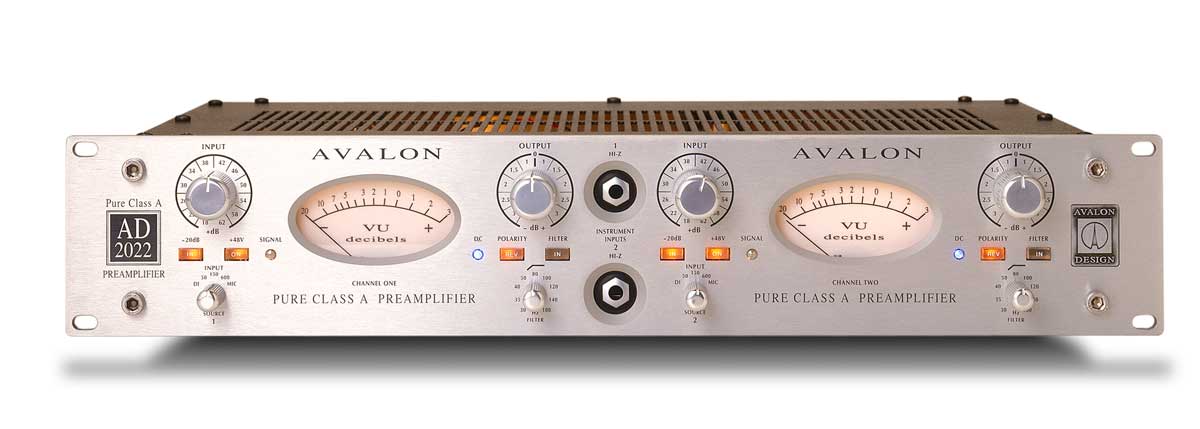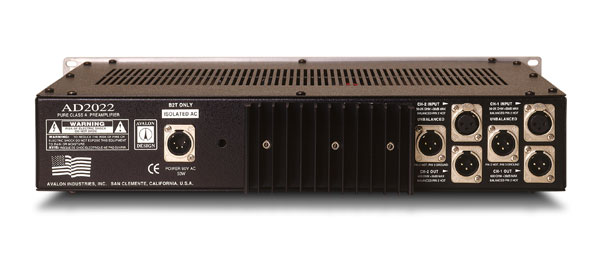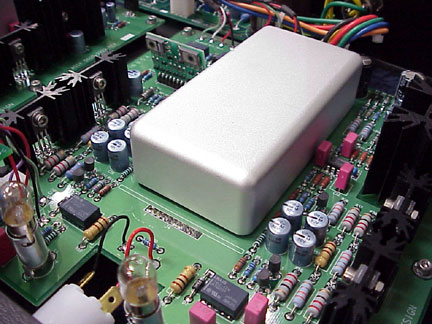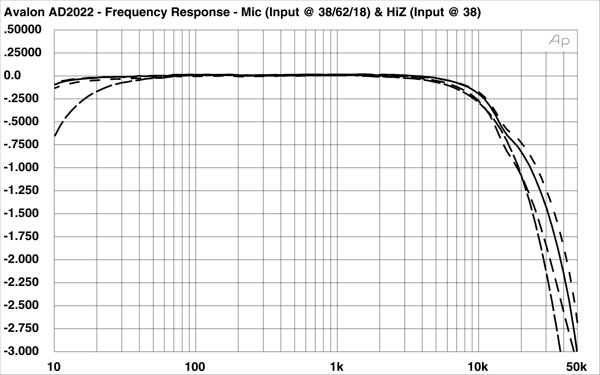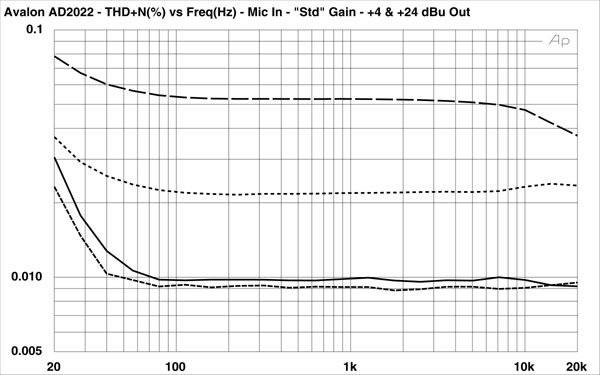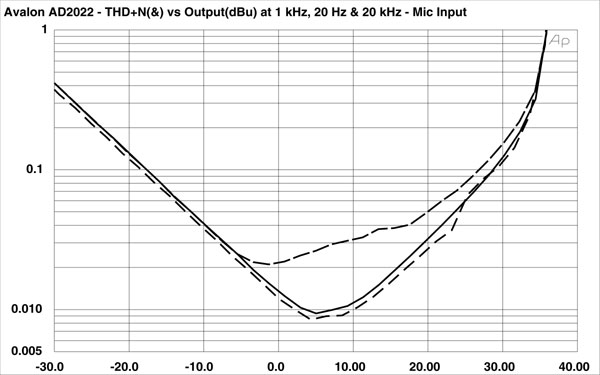
| REVIEWS: | |||
|
AVALON DESIGN AD2022
Dual Mono Microphone Preamplifier
Features The AD2022 ($3,000) is a fully discrete, symmetrical,
Class A microphone preamplifier that includes all the sonic strengths
of the renowned M2, M22 and M5 preamplifiers. It also has several additional
features, including an improved high-voltage Class A regulated power
supply, selectable impedance, Hi-Z instrument inputs, silver wiring, double-plated circuit boards and a variable-passive high-pass
filter - all packed into a 15-pound, 12-inch deep, 2 RU box - and is
designed to provide the utmost in audio quality. The rear panel of the AD2022 features a female XLR connector for each channel's microphone input. Each channel is equipped with two male XLR connectors for audio output. The first is balanced, pin-2 hot; the second is unbalanced, pin-2 hot, pin-3 ground.
The 12-position stepped input knob allows the input
gain to be adjusted from +18 dB to +62 dB in 4 dB increments. An identical
knob provides output control allowing the signal to be trimmed +/-3
dB. The maximum output level is +36 dBu. Each channel features four switches that light when
activated. The +48V switch activates 48V phantom power. The input attenuator
switch activates a -20 dB passive attenuator. The Polarity switch reverses
the phase of the signal. The Filter switch activates the variable high-pass
filter. This 6 dB/octave passive filter is variable from 30 Hz to 185
Hz via a second small rotary switch. The 2022 features the same visually striking oval VU meters found on other Avalon boxes.
In Use I put the AD2022 to work under a variety of circumstances.
It always yielded fantastic results. The box is built like a tank and
it sounds outstanding. I used the preamplifiers on a wide variety of acoustic
instruments, including mandolin, violin, banjo and acoustic guitar.
In each circumstance I was more than pleased. The selectable impedance
is a godsend considering my love for ribbon microphones. I found the
new Royer SF-1 ribbon mic the perfect match for the 2022. I also had great results using the AD2022 on vocals.
I recorded vocals through the preamp using a Sony C-800G, an AKG 414
and an Audio-Technica 4033 — always achieving killer tracks. The
microphone preamplifier performed equally well with male and female
vocals. The high-pass filter sounded fantastic. I was amazed
at how little, if any, equalization was required when it was adjusted
properly. The filter leaves none of the phasey characteristics associated
with cheap HP filters and even when used drastically, the sound retains
its smooth, tight, well-defined characteristics. I also had good results recording keyboards and bass
directly through the front of the machine. These instruments' inputs
always had a full, punchy sound. I used the box extensively for several
days and I never encountered a situation where it didn’t perform
tremendously. Summary The Avalon AD2022 is a no-compromise microphone preamplifier with every feature imaginable and a sound quality that cannot be touched.
BENCH TEST
Inside of AD2022
Figure 1
Figure 1 (above) plots frequency response from the microphone input using maximum, minimum and standard gain, along with the response from the Hi-Z input using my standard setting of 38 on the switch. The curves don’t differ all that much. There is a bit more bass roll using the Hi-Z input, but it’s only 0.2 dB at 20 Hz. As usual, high-end response is best with minimum gain, but there is less change from high gain to low gain (-1.05 dB at 20 kHz with high gain, -0.72 dB at 20 kHz with low gain) than often is the case.
Figure 2 Figure 2 plots THD+N versus frequency at two output levels (+4 dBu and +24 dBu) using the microphone input and my standard gain setting of 38. The results are exemplary at +4 dBu where THD+N is below 0.010 percent from 75 Hz to 10 kHz on Channel 1 and from 50 Hz to 10 kHz on Channel 2. No complaints at +24 dBu considering that this is about as hard as you are ever likely to drive the preamp.
Figure 3 plots THD+N vs. output at 20 Hz, 1 kHz and 20 kHz using the microphone input and standard gain. As you can see, +4 dBu corresponds closely to the point of minimum THD+N; at that point the bottom curve was taken at 20 kHz, the solid (middle) curve is for 1 kHz and the top curve is for 20 Hz. Although distortion rises in the bass, all three curves pass through 1 percent THD+N at the same level (+36.2 dBu). This indicates that maximum output level is independent of frequency.
Edward J. Foster
Back to Reviews Index & User List |
Tel: +1 949 492 2000
©2023 Avalon Design USA LLC
